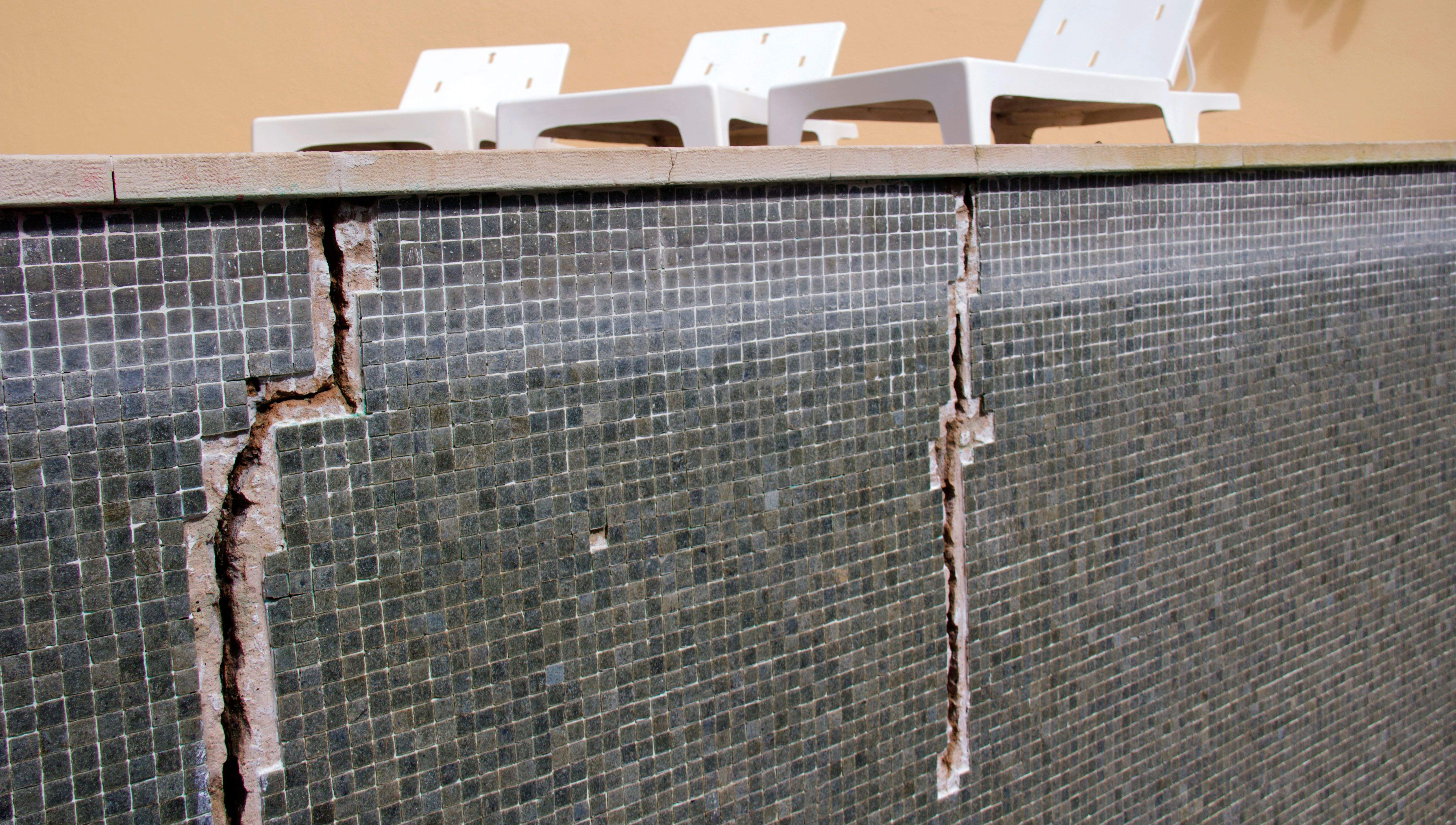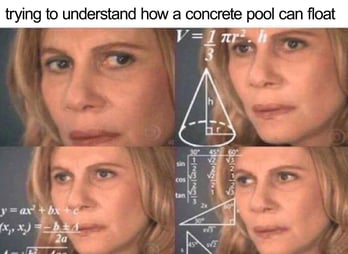
Concrete Pool Repair: Structural Problems
Pool Maintenance | Concrete Pool Information
Surface damage to a concrete swimming pool can be annoying. Structural damage to a concrete pool can be a catastrophe.
We think that both are serious enough to be considered before you buy your inground concrete pool (and we definitely recommend that you learn about these issues if you’re already a concrete pool owner).
Most major damage happens when the pool is designed, built, or maintained incorrectly, and many of the things we’re going to talk about here can be avoided. Since we at River Pools love seeing people happy with their new inground swimming pools (we manufacture fiberglass pools), we want to help you avoid these issues.
So, what are some of the things that can happen to your pool, and what are the signs to look for? When does it spell the end, and when can it be fixed? We’ll answer all of these questions and more in the following sections.
Concrete Pool Cracks
There are two main parts to any inground swimming pool:
- The pool surface (plaster, gelcoat, liner, etc.)
- The pool shell (concrete, fiberglass, metal, etc.)
A crack in your concrete swimming pool doesn’t always indicate that the pool shell is cracked. Most of the time, those cracks are limited to the surface layer and don’t go any deeper than the plaster finish. This means that they don’t typically cause leaks, but they can still make your algae problems worse or lead to calcium nodules.
Pool plaster cracks can usually be patched, or if they’re too bad, you can replaster your entire pool to fix them. Unfortunately, it is pricey to replace the plaster on your pool (about $10,000 and up).
Structural Cracks
Structural cracks can appear anywhere on the pool, and they can develop in any pattern or direction. You might see them in the corners of the pool or around the skimmer, but they can develop in any area. Many times, a structural crack will create a leak, and you might notice that you have to top off the water in your pool more often before you see the crack.
What causes concrete pools to crack?
- Poor construction or engineering
- Ground movement
- Groundwater
- Shifting soil around the pool shell (due to poorly compacted soil during construction)
- Freezing and thawing
You might see some structural cracks in your pool if the pool was built incorrectly or if it was made with low-quality materials. It might even crack if it was installed in a bad spot (too close to another structure, for example). Ground movement, like an earthquake, can also cause the pool to crack as well as hydrostatic pressure from groundwater.
If your contractor failed to compact the soil correctly around your pool, your pool could shift and settle over time, which almost inevitably causes structural damage. Finally, the freezing and thawing of groundwater around your swimming pool causes the ground to expand and contract over the cold months. This can also cause the concrete in your swimming pool to crack.
Pro tip: If you notice a crack, get your pool fixed ASAP. The longer you wait, the worse your problem can become. And no matter which route you take to fix it, try to find out what’s causing the crack so that you can prevent further damage.
Pool concrete repair: How to fix a cracked pool
You’ll have a few options when it comes to fixing structural cracks in a concrete pool shell:
- Inject epoxy or polyurethane into the crack to seal it off
- Apply hydraulic cement over the crack
- “Staple” the crack closed with rebar staples
- Tear out and redo the damaged area of the pool
Injecting epoxy or polyurethane aren’t the best long-term solutions, but they might be the most affordable in the short-term. Applying hydraulic cement is similar to injecting epoxy in terms of durability. It can be a good temporary solution, but it doesn’t address the root of the problem.
Stapling the crack can prevent further cracks and keep that area from opening up again. This can cost anywhere from $1,000 to $3,000 and up. Redoing the damaged section altogether can cost much more than stapling it, but the final cost will depend on your contractor and the extent of the work that needs to be done.
How to know if your concrete pool has a structural crack or surface crack
If you see a crack in your swimming pool, you might not be able to tell at first glance if it’s coming from the plaster or the shell of the pool. To be honest, the easiest way to find out is to call in a pool expert, but there are a few ways that you might be able to tell on your own if the crack is in the plaster or the shell:
- A structural crack on a pool will look deeper (almost like a fissure)
- You might notice your pool is losing water, or a leak test comes back positive (this would mean you have a structural crack)
- Surface cracks are often smaller, forming in clusters (craze cracks)
- You might see the plaster flaking away, but the concrete underneath is intact
Ultimately, it’s a good idea to call in a concrete pool repair specialist or engineer to check out the crack and explain what type of repair it will require. The best thing to do in a situation in which you have a structural crack is to act fast.
Your Concrete Pool Can Float
If there’s one single form of concrete pool damage that is cataclysmic, it’s your pool popping up out of the ground. This is a true pool owner’s nightmare that we would not wish on anybody.
Why does this happen?
Two words: hydrostatic pressure. The water in the ground underneath your swimming pool can create enough pressure to push your pool upwards and out of the ground if you’re not careful when draining your pool.
Think your concrete pool is too heavy to float? Think again. If a cruise liner ship that weighs as much as 250 large blue whales can float, so can your concrete pool. It’s just one of those logical things that confuse people.

Photo credit: Know Your Meme
There’s one easy way to prevent your pool from floating: don’t haphazardly drain your pool.
Always seek professional assistance when your pool needs to be drained, and try not to leave it empty for long periods. Make sure that your pool servicer knows what they are doing and that they are aware of the risks and pitfalls of draining a pool. You might want to ask them the following questions to make sure they are right for the job:
- Have you verified whether groundwater is an issue in my area?
- What do you usually do to relieve hydrostatic pressure while draining a pool?
- Do you ensure that the hydrostatic valve doesn’t become clogged while draining a pool? How?
- When is it a bad time to drain a pool? (It’s typically not the best time to try to drain your pool after a flood or rainstorm, etc.)
- How many times has a pool popped up on you during or after draining it?
The answers to these questions should help you get a better idea of whether the pool servicer or contractor can handle the job.
What should I do if my concrete pool floats?
If your concrete pool does float, you might have a few different options depending on the extent of the damage. Unfortunately, there’s no simple way to shove the pool back into the ground once it pops out.
Much of the time, the pool will also develop severe cracks, or it could even break in half if the force of the water is powerful enough. The plumbing is often destroyed, and the deck around the pool is usually unsalvageable. If the pool is too severely damaged, your only real option is to have it removed.
If the pool has only popped out a little bit and doesn’t have too much damage, you might be able to repair it and restore the deck to match the pool’s new height. This can cost thousands of dollars or even tens of thousands of dollars to repair. Removing a pool, in comparison, can cost $5,000 to $15,000 or more. If you just want to fill the pool in, you can expect to pay between $3,500 and $5,000 (compare the two methods here).
Side note: We’re sure you’ve noticed that not all pools that sit empty will pop up out of the ground. This is because groundwater isn’t an issue in every area. If you live somewhere low where the water table is high, like near a lake or river, be extra cautious when draining your pool. Even if you don’t think this will be an issue, it’s always a good idea to be safe and double-check with a professional pool servicer.
Aim to Buy a High-Quality Pool
A swimming pool is not like a car. You can’t trade it in or sell it for whatever you can get if it’s faulty. When you buy the pool, you buy the problems, and you’re stuck with the bill to fix them.
It’s essential that you properly vet your pool builder before you hire them to build your swimming pool. It’s also a good idea not to DIY all of your pool maintenance. If your pool needs to be drained for any reason, we recommend calling in an experienced professional to help you out. It will cost you a little more now, but it can prevent more extensive and costly damage to your pool.
At River Pools, we manufacture world-class fiberglass pools for customers across North America. Feel free to take a look at our catalog of models, visit our learning center, or use the button below to request pricing on a fiberglass pool today.
Up Next:
Inground Concrete Swimming Pool Cost and Price Guide 2020
What is an Above Ground Concrete Pool? Cost, Construction, Problems
Inground Saltwater Pool Cost: Salt, Cells, Generators, and More





